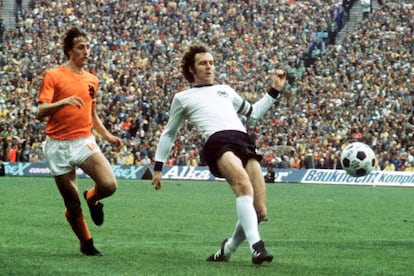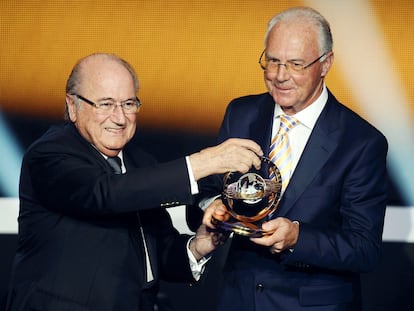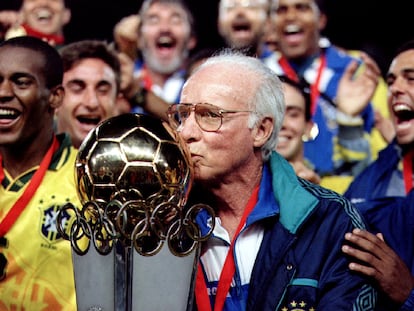Beckenbauer, the soccer player in a tuxedo
The Bayern and West Germany great is regarded as one of the finest players in history, alongside the canonized quintet of Pelé, Alfredo Di Stéfano, Johan Cruyff, Diego Maradona and Lionel Messi

The Cruyff family cherishes as its most treasured trophy the shirt that Franz Beckenbauer wore during the 1974 World Cup final in Munich, where West Germany defeated the Netherlands. The two icons of that famous final, Beckenbauer and Johan Cruyff, exchanged jerseys after the game and the Barcelona legend’s son, Jordi Cruyff, places such value on it that he has repeatedly refused to return it in exchange for the one handed to Beckenbauer by his father, who died at the age of 68 in 2016.
Both were soccer players, but equally proud characters who shared a mutual admiration and met again later when radical Cruyffist Pep Guardiola went on to coach Bayern Munich after leaving Barcelona. Beckenbauer had fallen in love with the now Manchester City coach when his team was thrashed 4-0 at the Camp Nou by the Catalan giants in the 2009 Champions League quarterfinals.
Beckenbauer had such elegance that he never left even the muddiest pitch in the world with a dirty shirt, even in his nominal role as a defender, not that he was often seen in his own penalty area, instead playing the ball out from the back, his head raised, his chin shining, and even with one arm in a sling due to a dislocated shoulder, as was the case in the 1970 World Cup semi-final against Italy, who were victorious in extra time in a 4-3 win known as the game of the century.
In those days, teams did not deploy two central defenders, one right-footed and one left-footed as today, but a marker to track the center-forward and a player with a free role, a demarcation that Beckenbauer made his own with his panoramic soccer, typical of the midfielder he was originally, equally precise in the short pass as in raking ones, unique in the way he struck the ball, a total player and the undisputed leader of his club team, Bayern, and his national team. Despite his playing position, Beckenbauer is regarded as one of the finest players in history, alongside the canonized attacking quintet of Pelé, Alfredo Di Stéfano, Cruyff, Diego Maradona and Lionel Messi.
He had so much quality and was so composed that he seemed to play in a tuxedo, always elegant and imposing, as attractive to the public as he was to the ball, the key player in understanding the hegemony of Bayern Munich and West Germany in the early 1970s. His unparalleled reading of the game and his dominance of tempo, as well as his authority and confidence, eventually turned him into the figure of an emperor, popularly known as Der Kaiser.
Beckenbauer’s brand as a player was so powerful that it always prevailed over that of Beckenbauer the coach, even when he won the World Cup with West Germany in Italy in 1990, and above all over that of administrator and president, positions in which he was a much less virtuous protagonist in the eyes of soccer and society as a whole after he retired with the New York Cosmos in 1983.
Although their intelligence and personality made them close, as well as their intrigues with their respective national teams, it was always taken for granted that Beckenbauer’s antagonist by definition was Cruyff, especially because of the duels they held in matches between West Germany and the Netherlands, and between Ajax and Bayern. Cruyff used to say that Beckenbauer defended by attacking, which was how the Dutchman liked to play and wanted his teams to play. “I was a world champion, but Johan was a better player than me,” Beckenbauer once said. Mourning the death of his rival and friend, he added: “He was not only a friend, but a brother to me.”
Sign up for our weekly newsletter to get more English-language news coverage from EL PAÍS USA Edition
Tu suscripción se está usando en otro dispositivo
¿Quieres añadir otro usuario a tu suscripción?
Si continúas leyendo en este dispositivo, no se podrá leer en el otro.
FlechaTu suscripción se está usando en otro dispositivo y solo puedes acceder a EL PAÍS desde un dispositivo a la vez.
Si quieres compartir tu cuenta, cambia tu suscripción a la modalidad Premium, así podrás añadir otro usuario. Cada uno accederá con su propia cuenta de email, lo que os permitirá personalizar vuestra experiencia en EL PAÍS.
¿Tienes una suscripción de empresa? Accede aquí para contratar más cuentas.
En el caso de no saber quién está usando tu cuenta, te recomendamos cambiar tu contraseña aquí.
Si decides continuar compartiendo tu cuenta, este mensaje se mostrará en tu dispositivo y en el de la otra persona que está usando tu cuenta de forma indefinida, afectando a tu experiencia de lectura. Puedes consultar aquí los términos y condiciones de la suscripción digital.
More information
Archived In
Últimas noticias
The Bolsonaro surname: An advantage or liability in Brazil’s 2026 presidential elections?
Raúl Rocha, from jet-setting with Miss Universe to arms trafficking and fuel theft
80,000 barrels of Mexican oil sent to Cuba: Havana drawn into the US–Mexico clash
Human rights activists, opposition members, and a minor: Maduro’s other political prisoners
Most viewed
- Reinhard Genzel, Nobel laureate in physics: ‘One-minute videos will never give you the truth’
- Pablo Escobar’s hippos: A serious environmental problem, 40 years on
- Charles Dubouloz, mountaineering star, retires at 36 with a farewell tour inspired by Walter Bonatti
- Why we lost the habit of sleeping in two segments and how that changed our sense of time
- The fall of a prolific science journal exposes the billion-dollar profits of scientific publishing











































